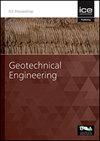双土压力平衡隧道开挖-软土城市实例监测与数值研究
IF 1.7
4区 工程技术
Q3 ENGINEERING, GEOLOGICAL
Proceedings of the Institution of Civil Engineers-Geotechnical Engineering
Pub Date : 2022-07-04
DOI:10.1680/jgeen.21.00165
引用次数: 1
摘要
近几十年来,经常采用数值计算从技术和经济角度对地下工程进行优化设计。如今,使用这些工具可以获得高效和负担得起的设计。城市隧道掘进机掘进过程的模拟是一个复杂的土-结构相互作用问题。因此需要使用连续统数值方法。本文采用有限差分的三维编码。本研究的参考案例是法国里昂地铁D线项目,由于挡土墙的存在,地表存在非对称荷载。建立了精确的现场监测系统,以评估双隧道机械化开挖过程中的地面运动。以实测数据为参考,验证了所建立的三维模型的有效性和准确性。为了模拟隧道掘进过程,开发了分段衬砌安装的模拟程序。采用塑性硬化(PH)和具有完全塑性的线弹性(Mohr-Coulomb剪切破坏准则)两种本构模型来模拟土的行为。简单的土本构模型存在一些缺陷,可通过塑性硬化方法加以克服。挡土墙的存在导致了非对称荷载条件;先进数值模型预测的沉降槽与实测沉降槽吻合较好。本文章由计算机程序翻译,如有差异,请以英文原文为准。
Twin earth pressure balance tunneling – Monitoring and numerical study of a soft soil urban case
In recent decades, numerical calculations are often used to optimize from a technical and economical point of view the design of underground works. Nowadays, using these tools permits to obtain efficient and affordable designs. The simulation of the tunneling procedure in case of the use of a tunneling boring machine and in urban areas is a complex soil/structure interaction problem. The use of continuum numerical methods is then required. In this paper, a three-dimensional code using finite differences is used. The reference case of this study is the Lyon metro line D project in France where a non-symmetric load is present at the surface due to the presence of a retaining wall. An accurate on-site monitoring system was set up to assess ground movements during the mechanized excavation of twin tunnels. The collected data is used as a reference to show the validity and accuracy of the developed three-dimensional model. A procedure that simulates the segmental lining installation is developed to simulate the tunneling process. Two constitutive models were used to simulate the soil behavior: Plastic Hardening (PH) and linear elasticity with perfect plasticity (Mohr-Coulomb shear failure criterion). The simpler soil constitutive model shows some drawbacks which can be eliminated by using the Plastic Hardening. The existence of a retaining wall induces a non-symmetric load condition; however, the settlement trough predicted by advanced numerical models shows a good agreement with the monitoring data one.
求助全文
通过发布文献求助,成功后即可免费获取论文全文。
去求助
来源期刊
CiteScore
4.40
自引率
4.50%
发文量
68
审稿时长
3 months
期刊介绍:
Geotechnical Engineering provides a forum for the publication of high quality, topical and relevant technical papers covering all aspects of geotechnical research, design, construction and performance. The journal aims to be of interest to those civil, structural or geotechnical engineering practitioners wishing to develop a greater understanding of the influence of geotechnics on the built environment.

 求助内容:
求助内容: 应助结果提醒方式:
应助结果提醒方式:


